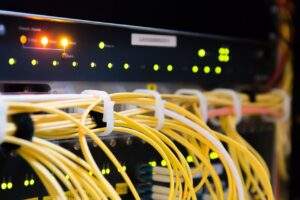Why Do The Trustless Networks Of Blockchain fail to scale well?
Whenever the audiences talk about the blockchain networks and the algorithms related to the same, they might think if or not the blockchains (somewhere relying upon the security offered by the cloud) fail to respond well to the trustless networks. The reason for the same is that these networks might acquire the assets that require the security standards for better encryption

Moreover, those who might rename themselves as QuickBooks Hosting Providers will also nod their heads and avoid the networks to mingle with the blockchains. If in case this occurs, the difficulties in carrying out the computational logics and mapping the same with the operational challenges won’t be avoided – at all.
Henceforth, one must analyze the transactional logs of the blockchain databases and detect the risky areas which might deteriorate the nodes carrying the validated datasets. Even the sender need not trust these trustless networks and try enhancing the existing efficiencies of the available blockchains – either four or fifty.
Some Of The Reasons Which Don’t Allow These Blockchains Scale Effortlessly
In absence of the synchronizations at the relevant times, the miners must not expect the transactions to be processed successfully.
Even there are many reasons due to which the majority of the miners prefer to revoke the transactions – that are already in the midst of the processed state – just because the remaining nodes somewhere accessing the trustless networks might not destroy the competencies.
Moreover, some of the miners – might interfere with the QuickBooks Cloud not accepting such trustless networks. For those, the advice is that they must read these reasons – explained briefly – and then, make the relevant decisions so that the associated destructions may be prohibited (without emptying the databases somewhere inheriting the characteristics of these trustless networks).
Reason Number One – Mismatched Communications Amidst The Senders And These Receivers
Whenever there is a dissemination of the datasets (or the acquired information) between the sender and the receiver (who is a miner(s)), the carriers need to send the appropriate signals so that the receiver might not acquire the datasets in a destructed format.
Furthermore, those who prefer to avoid Cloud QuickBooks hosting specifications at the required times must also understand the fact that the communication must be made successful by the mutual aggregation of the encrypted signatures.
If in case the signatures are traversing onto these trustless networks, the chances for the attacks onto the blockchains will increase because the information (traversing in the form of the datasets) won’t be accepted by the miners. Consequently, this is because these trustless networks won’t allow the encrypted signatures to be recognized by both these parties feasibly.
This will assertively promote the miscommunication amongst both because the base (which is an encrypted signature) is now not able to block the impact of these trustless networks which are interfering amongst the communications [between the sender and the miner(s)]. Due to this, the other nodes acting as the sender or the miner(s) will also not recognize each other and initiate questionnaires onto the signatures acting as a connector for those.
And scalability is such a factor that must not be avoided if the nodes participating in these networks of the blockchains are planned to increase in controlled or either uncontrolled numbers. So, all this does not allow the nodes (somewhere connected with the trustless networks) to scale themselves apprehensively which may also invite the non-trustworthiness from the blockchain users.
# Reason Number Two – Clearing The Transactional Logs Without Emptying The Databases
Since more than one-billion individuals prefer to join the blockchain networks in the coming years, it becomes necessary for the related servers to keep their tracks and supervise the transactional logs. However, from those individuals, there might be some not accepting the robustness of the Qb Hosting in streamlining the processes connected with it.
They must not ignore these logs because such trustless networks will consume the allocated bandwidth(s) uncontrollably thereby not allowing the miners or the other nodes to analyze the transactions stored onto these logs.
Even to scale the existing number of blockchains, it becomes imperative to clear or empty the overall databases or these transactional logs somewhere accessing their computations at peculiar speeds. This must be done privately by the miners because if the wait is done for seeking the appropriate majority, this might promote the non-utilization of the resources and thereby, not allowing the miners to focus more on such logs.
But before such logs are cleared, it is essential to understand the dynamics of these trustless networks at those times and after doing that, the appropriate actions regarding emptying the databases or clearing the transactional logs need to be planned.
And if in case there are some hindrances offered by the associated risks of the security, they must be catered and systematically processed to the participating miners. Through this, the factors not allowing the blockchains to scale well with the available resources may now be estimated and the logs may also be deleted or moved to trash for some periods. This will help the miners synchronize their datasets with much confidence and more resilience.
Should One Neglect The Impacts These Trustless Networks Deliver?
Either the developers are planning some methodologies that might re-store the strengths of these blockchains or destroying them – with appropriate measures, it is imperative to analyze the roots onto which these trustless networks might offer destruction to the blockchains.
Moreover, those who might plan to take a look at the available QuickBooks Remote Desktop Services should also not neglect the aforementioned factors (or the reasons) that can feasibly destroy the existing strengths of the databases onto which these blockchains synchronize and carry the relevant datasets at appropriate destinations.
Therefore, one must apply the suitable bandwidth(s) plus the configured hardware for the efficient operating of the blockchains and help the miners avoid the worldly renowned fifty-one percent [51%] attack.
This will encourage the available masses to track their royalties relying upon these networks so that they may mechanize the operations – either related to the logistics [or the supply chains] – and promote the accepted votes thereby helping them stabilize the unstable currencies regulated onto their blockchain accounts.







